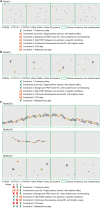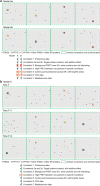Assembly of Dynamic P450-Mediated Metabolons-Order Versus Chaos
- PMID: 28255532
- PMCID: PMC5310546
- DOI: 10.1007/s40610-017-0053-y
Assembly of Dynamic P450-Mediated Metabolons-Order Versus Chaos
Abstract
Purpose of review: We provide an overview of the current knowledge on cytochrome P450-mediated metabolism organized as metabolons and factors that facilitate their stabilization. Essential parameters will be discussed including those that are commonly disregarded using the dhurrin metabolon from Sorghum bicolor as a case study.
Recent findings: Sessile plants control their metabolism to prioritize their resources between growth and development, or defense. This requires fine-tuned complex dynamic regulation of the metabolic networks involved. Within the recent years, numerous studies point to the formation of dynamic metabolons playing a major role in controlling the metabolic fluxes within such networks.
Summary: We propose that P450s and their partners interact and associate dynamically with POR, which acts as a charging station possibly in concert with Cytb5. Solvent environment, lipid composition, and non-catalytic proteins guide metabolon formation and thereby activity, which have important implications for synthetic biology approaches aiming to produce high-value specialized metabolites in heterologous hosts.
Keywords: Channeling; Cytochrome P450 oxidoreductase; Cytochromes P450; Membrane environment; Metabolon; Solvent environment.
Conflict of interest statement
Conflict of Interest
The authors declare that they have no conflict of interest.
Human and Animal Rights and Informed Consent
This article does not contain any studies with human or animal subjects performed by any of the authors.
Figures




Similar articles
-
Characterization of a dynamic metabolon producing the defense compound dhurrin in sorghum.Science. 2016 Nov 18;354(6314):890-893. doi: 10.1126/science.aag2347. Science. 2016. PMID: 27856908
-
Molecular snapshots of dynamic membrane-bound metabolons.Methods Enzymol. 2019;617:1-27. doi: 10.1016/bs.mie.2018.12.001. Epub 2019 Jan 23. Methods Enzymol. 2019. PMID: 30784399
-
Plasticity of specialized metabolism as mediated by dynamic metabolons.Trends Plant Sci. 2015 Jan;20(1):20-32. doi: 10.1016/j.tplants.2014.11.002. Epub 2014 Nov 27. Trends Plant Sci. 2015. PMID: 25435320 Review.
-
Stabilization of dhurrin biosynthetic enzymes from Sorghum bicolor using a natural deep eutectic solvent.Phytochemistry. 2020 Feb;170:112214. doi: 10.1016/j.phytochem.2019.112214. Epub 2019 Nov 30. Phytochemistry. 2020. PMID: 31794881
-
The catalytic function of cytochrome P450 is entwined with its membrane-bound nature.F1000Res. 2017 May 9;6:662. doi: 10.12688/f1000research.11015.1. eCollection 2017. F1000Res. 2017. PMID: 28529725 Free PMC article. Review.
Cited by
-
Unleashing the Synthetic Power of Plant Oxygenases: From Mechanism to Application.Plant Physiol. 2019 Mar;179(3):813-829. doi: 10.1104/pp.18.01223. Epub 2019 Jan 22. Plant Physiol. 2019. PMID: 30670605 Free PMC article. Review.
-
Deletion of biosynthetic genes, specific SNP patterns and differences in transcript accumulation cause variation in hydroxynitrile glucoside content in barley cultivars.Sci Rep. 2019 Apr 5;9(1):5730. doi: 10.1038/s41598-019-41884-w. Sci Rep. 2019. PMID: 30952890 Free PMC article.
-
Metabolic engineering for the synthesis of steviol glycosides: current status and future prospects.Appl Microbiol Biotechnol. 2021 Jul;105(13):5367-5381. doi: 10.1007/s00253-021-11419-3. Epub 2021 Jul 1. Appl Microbiol Biotechnol. 2021. PMID: 34196745 Review.
-
Stress-related biomolecular condensates in plants.Plant Cell. 2023 Sep 1;35(9):3187-3204. doi: 10.1093/plcell/koad127. Plant Cell. 2023. PMID: 37162152 Free PMC article.
-
Cyanogenesis in Arthropods: From Chemical Warfare to Nuptial Gifts.Insects. 2018 May 3;9(2):51. doi: 10.3390/insects9020051. Insects. 2018. PMID: 29751568 Free PMC article. Review.
References
-
- Sweetlove LJ, Fernie AR. The spatial organization of metabolism within the plant cell. Annu Rev Plant Biol. 2013;64:723–746. - PubMed
-
- Laursen T, Moller BL, Bassard JE. Plasticity of specialized metabolism as mediated by dynamic metabolons. Trends Plant Sci. 2015;20:20–32. - PubMed
-
- Moller BL. Dynamic metabolons. Science. 2010;330:1328–1329. - PubMed
-
- Srere PA. Complexes of sequential metabolic enzymes. Annu Rev Biochem. 1987;56:89–124. - PubMed
Publication types
LinkOut - more resources
Full Text Sources
Other Literature Sources
Research Materials
